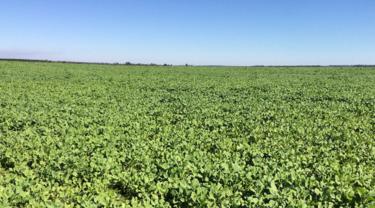Agrisoma Biosciences’ global expansion is bearing fruit just a few years after the Quebec business powered the world’s first 100 per cent bio-fueled jet flight in Ottawa in 2013.
Farmers in the U.S. and South America grow the agricultural-cleantech company’s oilseed and Agrisoma continues to explore new markets.
“Export growth is really going to fuel our growth because the market for biofuels in Canada is really small,” says president and CEO Steven Fabijanski.
The global aviation industry uses about 320-billion litres of jet fuel a year and the International Air Transport Association aims to cut carbon emissions in half by 2050, thanks in part to alternative fuels.
Gatineau-based Agrisoma spent a decade developing a high-yield Brassica carinata oilseed that produces a biofuel while the remaining solids make a high-protein GMO-free animal feed.
“We’ve produced over 10-million litres of advanced biofuels with our partners,” says Fabijanski.
Partnerships are key to developing exports, he says. Strategic partners help work with farmers, navigate regulatory requirements and process the harvest into biofuel.
To build its export market, Agrisoma had to demonstrate the crop was low-carbon and sustainable and would not replace food production.
Farmers in Florida grow the crop over the winter when land normally lies fallow. That success attracted Finnish giant UPM Biofore to sign a long-term supply deal with Agrisoma. The partners are ramping up production in Uruguay and Brazil, where B. carinata can grow in the off-season without disrupting food crops. UPM also handles shipping and biofuel processing.
In early 2017 the government of Uruguay agreed to promote Agrisoma’s B. carinata as a second cash crop. The company is also considering new markets in Argentina and Paraguay.
About two-thirds of seed sales are now outside Canada.
“We expect to continue to double or triple our volumes and a lot of that is going to be driven by these offshore markets like South America,” says Fabijanksi.
The company is also testing B. carinata varieties in Australia and Europe and eventually the plant could be grown in North Africa, Eastern Europe and China.
Financing the company in a “more conservative Canadian environment” has been a challenge, adds Fabijanksi. Agrisoma tapped several federal support programs, as the company graduated from Sustainable Development Technology Canada’s cleantech funding program.
In 2016 Agrisoma closed a $15.4-million Series B financing round to support global expansion.
The company is also interested in working capital guarantees or risk mitigation “to let us expand faster and preserve equity,” says Fabijanski.
The exchange rate is another challenge. “We produce our products in Canadian dollars and sell in U.S. dollars, but we hire talent in the U.S. and our funding comes in Canadian dollars. It’s a double-edged sword but we’d prefer a more competitive dollar.”
Meanwhile, Fabijanski is enthusiastic about the government’s push to position Canada as a clean-tech leader and pursue free-trade deals such as CETA.
“That’s going to be really important for us,” he adds.
Export insights with president and CEO Steven Fabijanski
What advice would you give to a SME breaking into a new export market?
You need to understand where you can go and where the best partnerships are, because you’ll never do this alone. And you’ll never do it in recalcitrant markets. Everybody tends to go to the U.S. but when you look at the policy and the [political and regulatory] climate there, it’s challenging. A place with a better-suited policy allows you to get established and demonstrate you have a viable global business. Really audition or interview your [potential business] partner to ensure you share the same objectives.
What’s the biggest lesson learned in going global?
We’ve learned that it really takes a lot of time to manage things and you’ve got to be able to have a global presence up and down the stakeholder list. When you move to a new location or a new county, unless you’ve got all the stakeholders engaged in that market, it’s going to be very challenging.
How would you summarize your export journey?
It has been really illuminating. The real key is to recognize your strengths – where you have knowledge and expertise – and very quickly bring in the outside expertise specific to the area so you can overcome small things that can get big. That local expertise really allows you to go very quickly.
What makes you most cautious about exporting?
I’m less cautious and more bullish. We see a very large appetite for our product and we believe we’ve approached it properly through the right partnerships and pinpointing the right locations. I don’t lose a lot of sleep around the opportunity here, it’s more around making sure you execute properly.





